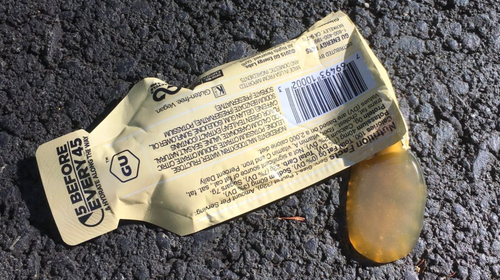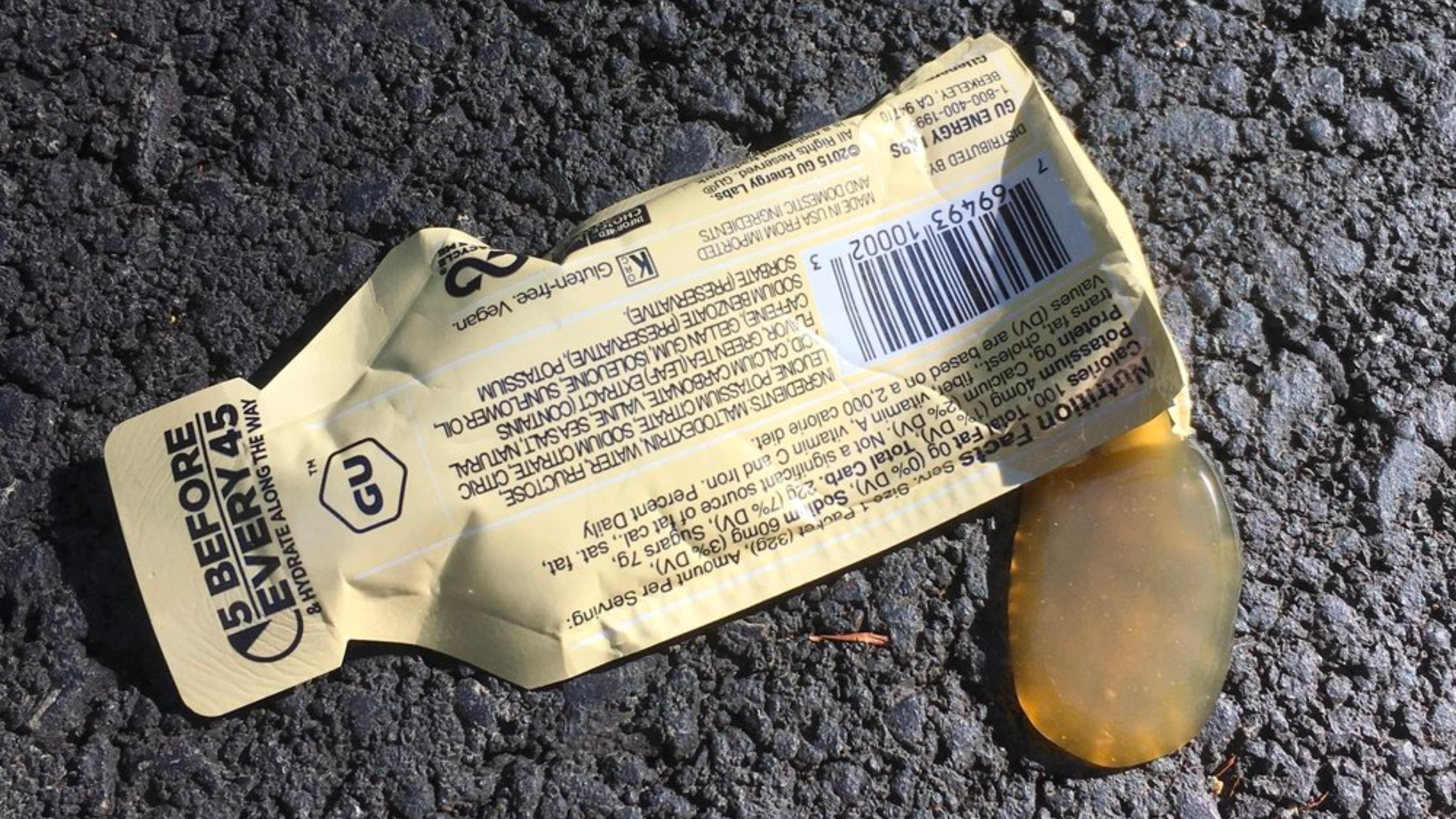I’m obsessed with running gels.��
“You’re hooked,” my fiancé would say every time I came home from a trip to my local running store with a heap of energy gels. “It’s not goo,” I would tell him. It’s gel.
I thought he was just gel-ous that I basically got to eat frosting on my long runs, sucking down flavors like salted caramel, birthday cake, campfire s’mores, and sea salt chocolate. (Now, my mouth is watering.)
I discovered the magic of gels when I started running marathons two years ago. It was a great trade-off in my mind—you’re running longer miles, so you get a reward about halfway. Fun! I distinctly remember running the Hamilton Glow Marathon in Hamilton, Ohio, and shouting at my dad on the side of the course, “I GET TO EAT A GEL SOON!”��
But, I’ll be honest: my zealousness for energy gels was not the most financially healthy habit. Gels are $1.60 a piece at my local running store, and I buy three or four a week to stick in my drawers, backpack, car, and jackets. After a year of this, I estimate I spent around $300 on gels alone.��
Even more concerning, I believed I wouldn’t be able to run well without gels and never completed a long run without one. I went out of town one weekend and didn’t bring any gels, so I refused to join my dad for a long run. At the time, I truly thought I wouldn’t get through half the run without a gel.
That particular weekend out of town was eye-opening. I knew I wanted to stop leaning on gels, but I still needed a way to replenish lost electrolytes and glycogen. So I decided I was going to start substituting energy gels with whole, real foods to prove I didn’t need them to be a good runner. It was time to face my fears and kick the crutch I’d been leaning on for over a year.
What to Look for in an Energy Gel Replacement
The editors at ��provided��a perfect resource for learning what I needed to do to fuel my long runs with natural foods.����
Authors Caitlyn Pilington and Malissa Rodenburg write: “Fueling is important during long runs, but your choice of what to fuel with lends itself to flexibility. Ultimately, all of our bodies are different and, therefore, tolerate things differently. You’ll no doubt see a majority of athletes fueling themselves with gels, blocks, sports drinks, or other commercial products. And there’s honestly nothing wrong with that—sports products are engineered to be absorbed properly and help you perform.”
There are all kinds of brands of energy gels, but I’ll be touching on my favorite, GU. Each packet contains 100 calories, 125 mg of sodium, 40 mg of potassium, 22 g of carbs, and 7 g of sugar. So, a gel replacement would need to cover those bases plus be compact, easily digestible, and (hopefully) tasty.��
Nutritionist Sarah Cuff focuses on holistic fueling, so she was eager to speak on the topic of replacing gels with whole foods. She says the three main factors to consider in a gel or whole-food replacement are sodium, carbohydrates, and sugars.
Sodium
If you’re a ‘super sweater’ like me (I could fill a bathtub wringing out my running clothes), you’ll want to pay close attention to this next bit.��
“When we sweat, sodium is the electrolyte lost at the highest proportion,” Cuff says. “So while most energy gels will include some potassium and magnesium and calcium, they are not necessarily required because we don’t lose them in any high amount when we sweat. Sodium is most important.”
She adds that the amount of sodium needed depends on a variety of factors, like how much you generally sweat, the temperature, and how much energy you’re exerting. Cuff says a good rule of thumb is if you’re drinking one liter of water an hour, you want to ensure you consume at least .
Learning this, I realized the sodium in my favorite GU gel and the whole food replacements don’t meet those standards, so I needed to supplement with sodium in my water.
“Some athletes who want to be as natural as possible might use coconut water and sprinkle sea salt in it—it’s not super tasty, though some people like it,” Cuff says. “I’d suggest getting a natural electrolyte drink such as or . Make sure they have at least 300 mg of sodium per serving.”
Carbohydrates
“Another important number we want to be looking at is the carbohydrate number because that’s what primarily fuels our long runs,” Cuff says. “We know from studies that we need 30 g to 60 g per hour on long runs and up to 90 g on really long runs (like marathons and ultramarathons) to adequately replace what we’re burning. The question is, where can we get those carbs?”
GU gels contain a sort of ‘super’ carbohydrate called maltodextrin, which is easily broken down while exercising and, therefore, great for most athletes – though it can cause gastrointestinal issues in some. So, my whole-food gel replacements must contain up to 90 grams of carbs and break down as easily as maltodextrin.��
Sugars
Sugars are required for the fueling process on long runs. Most gels use carbohydrates like maltodextrin to produce glucose and fructose. When you intake sugar, your body breaks it down into glucose and fructose, which can be used for energy right away.��
“Ideally, we’re looking at what’s easy for our digestive system to break down while we’re running,” Cuff says. “Sugar is digested pretty darn quickly. Now, straight table sugar would be difficult to stomach, but there are into small serving sizes. That’s a very natural whole food alternative to gels.”
My Energy Gel Replacements
Over the course of four weeks, I packed five different snacks on my longer runs, ranging from 10 to 16 miles, and ranked which ones worked the best for me and which ran me into the ground.
I also took Cuff’s advice and tried , which contains 70 calories, 17 g of carbs, 15 g of sugar, and 710 mg of sodium per serving.
White Bread with Honey
Calories: 132 | Carbs: 28 g | Sugar: 7 g | Sodium: 180 mg��
Probably the most boring sandwich I’ve ever made turned out to be my favorite energy source during this experimentation period.
I took one piece of white bread, drizzled on a little bit of honey, folded it up, and wrapped it in a sandwich bag. It fits neatly in my running pack around my waist and, even if it did get a little smushed, tasted glorious when I needed it. I had zero stomach troubles and felt as energized as when I took an espresso-flavored gel.��
Sweet Potato
Serving size: 4 oz. | Calories: 112 | Carbs: 26 g | Sugar 6 g | Sodium: 73 mg | Potassium: 448 mg
I’m a fiend for sweet potatoes. They’re excellent for running because of their phytochemical content, which can reduce post-workout inflammation, as I’m usually all kinds of inflamed after a good tenner.
I chose a small sweet potato, about the size of my palm, and cooked it long enough before my run so that it was cooled. I wrapped it in a paper towel and stuck it in my pack, and when the time came, I ate that sucker like it was a donut, skin and all.
I didn’t finish the whole thing because half did the trick. I felt fueled, and it digested well. The trade-off is the low sodium content, but because I supplemented it with my water, it evens out.
Banana
Serving size: Medium banana | Calories: 110 | Carbs: 28 g | Sugar 15 g | Potassium: 450 mg
Tried and true, I knew bananas would never fail me. This is often my pre-run snack because I can digest it easily, and it has carbs and natural sugars that can break down quickly. The downside is that it didn’t fit in my running pack, so I had to put it in my jacket pocket, which was a little uncomfortable. Like the sweet potato, there’s little sodium, but I had my supplemented water.��
Cereal
Serving size: ½ cup| Calories: 100 | Carbs: 20 g | Sugar 1 g | Sodium: 140 mg | Potassium: 170 mg��
For this energy gel replacement, I packed a cup of dry, plain Cheerios in a tiny baggie. While I’m a big fan of cereal, it’s not exactly easy to pour into your mouth while running. I also didn’t feel as fueled during the second half of my run, leading me to believe I might not have packed enough.
The issue is, if I packed anymore, I’d be crunching cereal for a whole mile. Plus, it really dried out my mouth and made me thirsty.��
Dates
Serving size: 2 dates | Calories: 133 | Carbs: 36 g | Sugar 32 g | Potassium: 334 mg��
I had high expectations for this snack. Dates are delicious, compact, and full of natural sugars, so it makes sense why runners sometimes substitute them for energy gels. However, I didn’t anticipate how the three Medjool dates would glob onto each other into a golf ball-sized glob. That wasn’t the biggest issue, though; my stomach did not do well with dates.
I experienced camping, bloating, and overall, my digestive issues caused me to cut the run short. Further research led me to discover that my body must not have liked the high amount of fiber and sulfites in the dates. So, this snack may work for some, but for me, it was a hard pass.��
Will I Give Up Energy Gels?
This experiment resulted in more than great runs and weird stares (have you ever seen a runner chomping on a whole sweet potato?!); it also provided me with the answer that I was looking for: I don’t need energy gels to be a good runner. They’re not a magical potion that gives me a boost as good as the speckled mushroom in Mario Kart.��
But, energy gels are a useful, efficient tool to quickly recover lost glycogen and keep you going on long runs. I certainly have no desire to give them up, but I know now that I can substitute a gel for whole foods if I so please. In the weeks after my trial, I purchased one gel. Given my track record, I’d say that’s pretty goo-d.��


